Disclosure: This article contains affiliate links. We may earn a commission from purchases at no extra cost to you, which helps our travel content.
There's something almost spiritual about standing alone in the Alaskan wilderness at -20°F, camera poised toward the heavens, waiting for that magical moment when the sky ignites with dancing ribbons of green and purple. After two decades of plating perfect dishes under fluorescent kitchen lights, trading that heat for Nome's winter chill felt like the ultimate palate cleanser for my creative soul. This remote Alaskan outpost might seem an unlikely destination for a New Zealand transplant like me, but when it comes to capturing the aurora borealis, Nome offers a raw, untamed canvas that few photography destinations can match.
Preparing for Nome's Arctic Challenge
Let me be straight with you—photographing the Northern Lights in Nome isn't like snapping sunset pics in Fiji. It's the photographic equivalent of cooking a 12-course tasting menu solo during a holiday rush. Challenging, exhausting, but ultimately transcendent when you nail it.
I learned this lesson the hard way my first night out. Despite twenty years of working in high-pressure environments, nothing prepared me for the bone-deep cold that seeps into your fingers when you're adjusting camera settings at 1AM in February. After just 30 minutes, my hands were nearly useless.
The game-changer? My heated gloves that allowed me to operate my camera while keeping circulation flowing. They're pricey but absolutely essential—think of them as the high-end chef's knife of arctic photography.
Equally important is proper layering. Under my motorcycle touring gear (which works surprisingly well for stationary cold-weather photography), I wore merino base layers that kept me warm without the bulk. Like a perfect mise en place, having your gear organized and accessible means you won't fumble in the dark when the aurora suddenly appears.
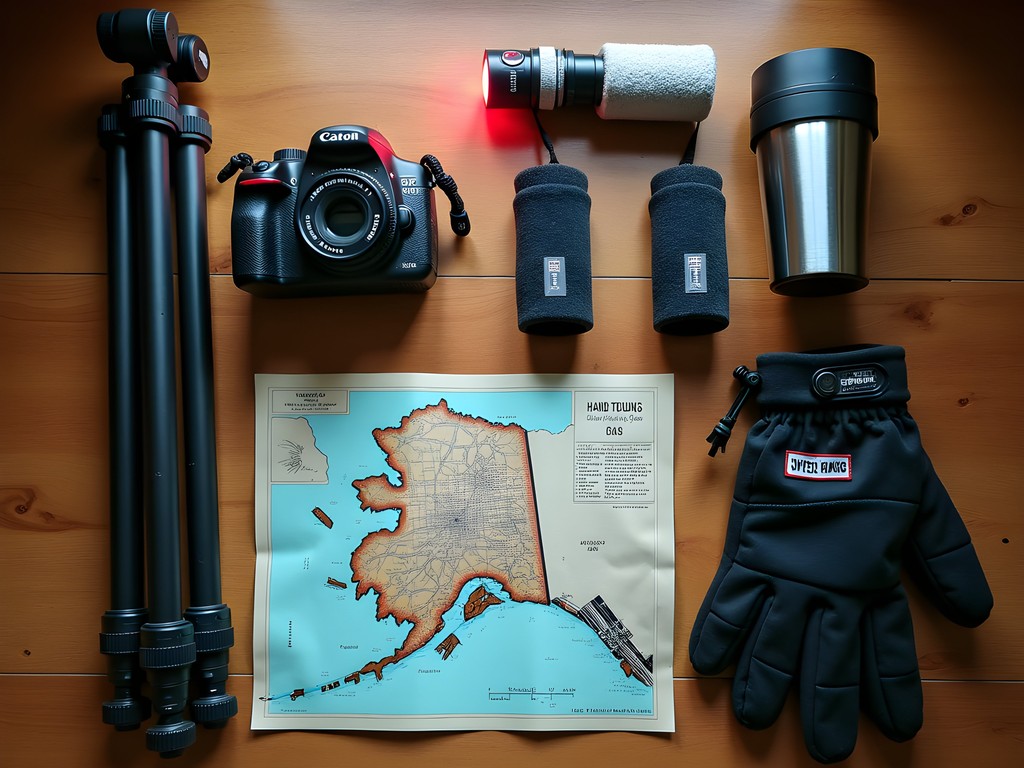
💡 Pro Tips
- Pack chemical hand warmers in abundance—tuck them everywhere, including camera bags to keep batteries warm
- Bring backup batteries and keep them in inner pockets close to your body heat
- Practice changing settings with gloves on before your trip—fumbling in -20°F is not the time to learn
Finding Your Light: Prime Aurora Viewing Locations
Nome's remoteness is both its challenge and its greatest asset for aurora hunters. With minimal light pollution and vast open landscapes, you'll find spectacular viewing opportunities within a short drive from town.
My favorite spot became Anvil Mountain, about 5 miles north of Nome. The abandoned White Alice Communication System—four massive Cold War-era antennas—creates an otherworldly foreground against the dancing lights. It's like finding the perfect garnish for a signature dish; it elevates the entire composition.
For coastal drama, I spent two unforgettable nights at Safety Sound Bridge (about 22 miles east on the Nome-Council Road). When the aurora reflects off the partially frozen water, it creates a doubling effect that's absolutely mesmerizing. Just be aware that this road can be challenging in winter conditions.
The most important tool in my location scouting wasn't my GPS but my aurora forecast app. This digital assistant helped me predict not just when the lights would appear but their intensity and movement patterns. Paired with my weather radio, I could make informed decisions about when to brave the elements and when to stay put.
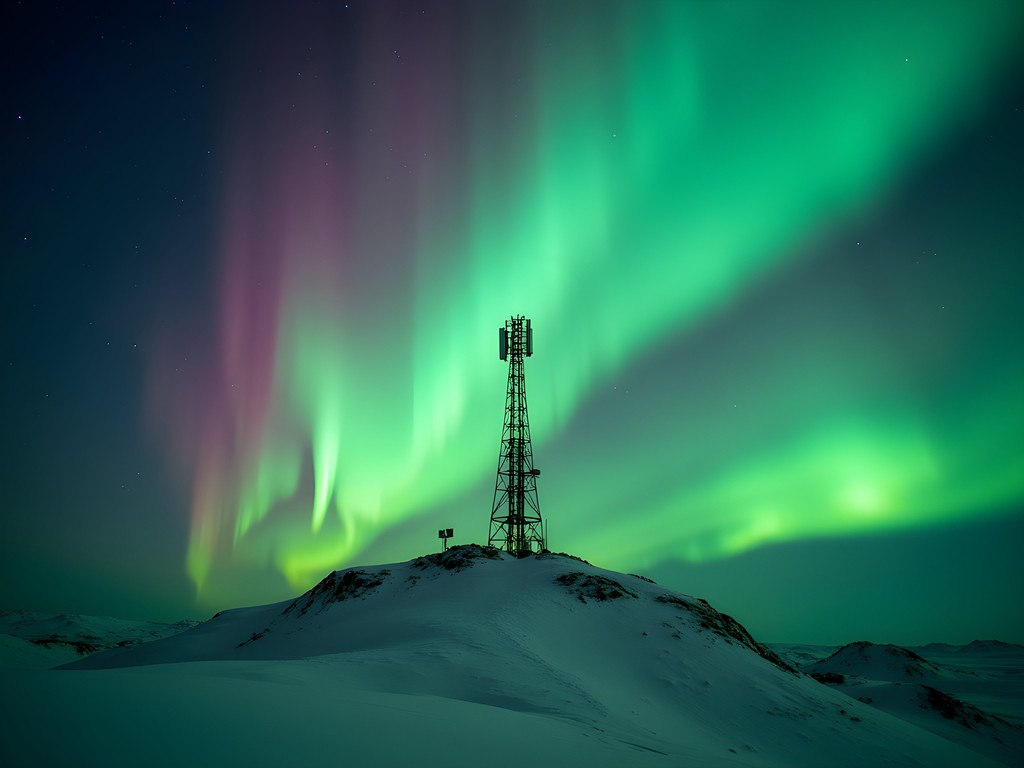
💡 Pro Tips
- Scout locations during daylight hours—you don't want to be finding your way in the dark
- The best aurora displays typically occur between 10PM and 2AM, but be prepared to wait all night
- Move away from Nome's minimal light pollution for the best photography results
Technical Mastery: Camera Settings and Techniques
Photographing the aurora is like preparing a delicate soufflé—timing and technique are everything. After numerous trial-and-error sessions (and some spectacularly failed shots), I developed a reliable formula for capturing Nome's light show.
Start with these base settings: aperture as wide as possible (I use f/2.8), ISO between 1600-3200, and shutter speed between 5-15 seconds depending on aurora activity. The more active the lights, the shorter your exposure should be to capture crisp movement rather than a green blur.
Focusing in the dark was my biggest challenge until I invested in a focusing aid. This ingenious tool helped me achieve perfect infinity focus even on moonless nights. For composition, I found that my ultra-wide lens captured the grand scale of the aurora better than standard lenses.
One technique I developed from my chef days: prepare everything in advance. Pre-set your camera while still warm indoors, attach your remote shutter release, and have your compositions planned. When the lights appear, you'll be ready to 'plate' your masterpiece without scrambling.
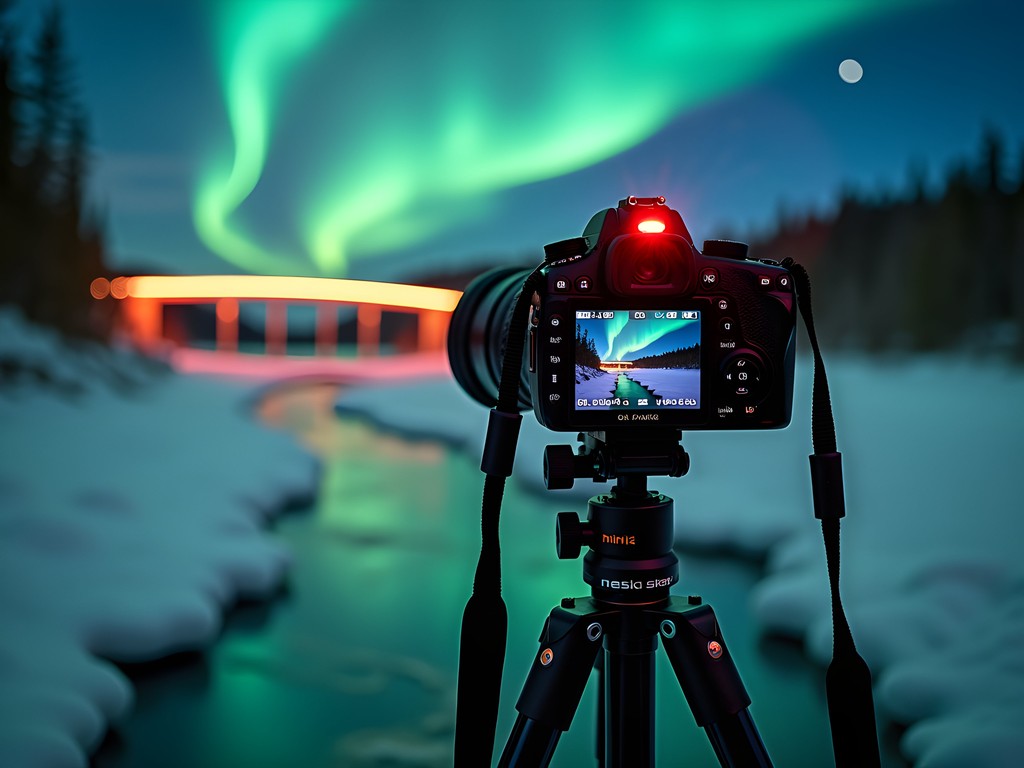
💡 Pro Tips
- Use the 500 rule (500 divided by your focal length) to determine maximum shutter speed before stars blur
- Shoot in RAW format—the dynamic range will be crucial during post-processing
- If your fingers get too cold to operate equipment, place your hands (not the camera!) near your vehicle's heater vents for quick warming
Survival Skills: Staying Safe in Nome's Winter
Twenty years in commercial kitchens taught me that preparation prevents disasters. In Nome's winter wilderness, that lesson becomes potentially life-saving.
Never—and I mean never—venture out alone without telling someone your plans. Cell service is spotty at best, and temperatures can plummet rapidly. My standard kit includes a satellite messenger which allows two-way text communication and emergency signaling anywhere. It's the safety net I won't leave without.
Vehicle preparedness is equally crucial. I learned this lesson when my rental car's heater couldn't keep pace with -30°F temperatures. Now I always pack a emergency car kit plus extra supplies including candles (which provide surprising warmth in a stranded vehicle), high-calorie snacks, and additional layers.
While photographing near Council Road, I met a local Inupiaq elder who shared wisdom I'll never forget: 'The cold here doesn't care about your photos.' He was right. No aurora shot is worth frostbite or worse. I now set timers on my phone to force regular warming breaks, and I've learned to recognize the early warning signs of cold exposure.
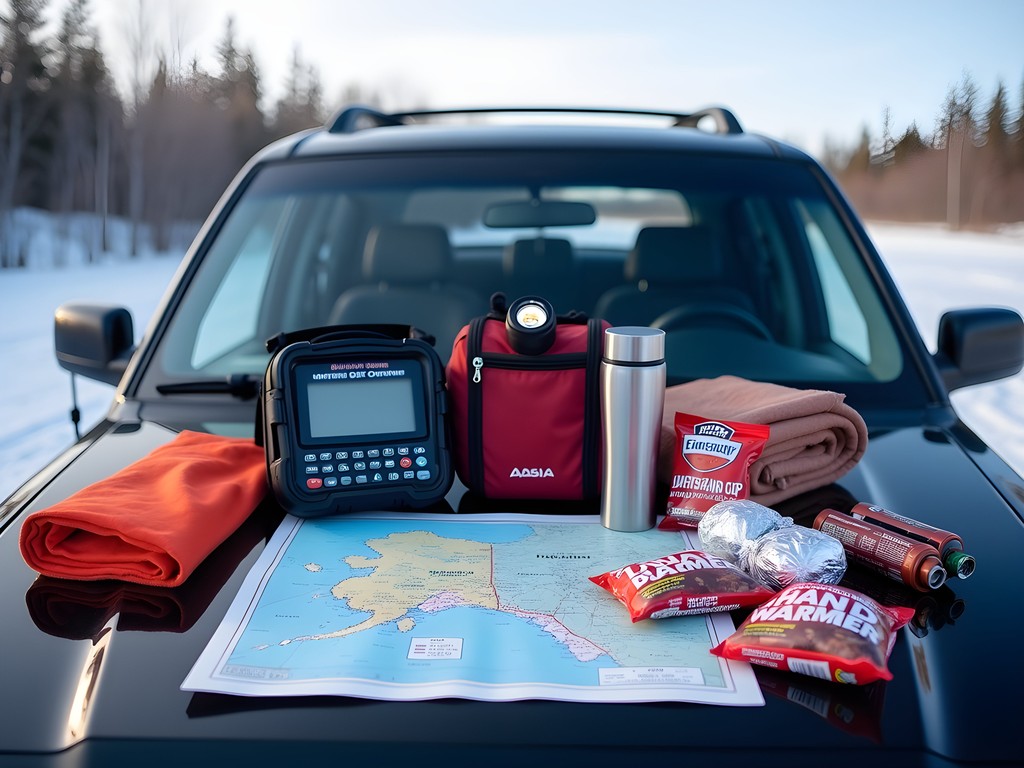
💡 Pro Tips
- Always maintain at least half a tank of gas in your vehicle
- Pack high-calorie snacks like nuts and chocolate—your body burns calories rapidly in extreme cold
- Use the buddy system whenever possible, especially when venturing beyond Nome's city limits
The Nome Experience: Beyond the Lights
Between aurora sessions, Nome offers unexpected cultural richness that enhances the photography journey. As a chef, I was particularly drawn to the local food scene, which blends Native Alaskan traditions with frontier practicality.
At Airport Pizza (yes, they actually fly pizzas to surrounding villages), I struck up a conversation with a local photographer who directed me to spots I'd never have found in guidebooks. The Polar Café became my morning ritual—their sourdough pancakes provided the sustenance needed for long nights in the cold.
Don't miss the Carrie M. McLain Memorial Museum to understand Nome's gold rush history and indigenous heritage. The context deepened my appreciation for the landscapes I was photographing.
While accommodations are limited, I recommend the compact travel humidifier as an essential room addition. Nome's heated indoor air is brutally dry, and waking up with a parched throat before a night of photography is miserable. This tiny device saved my sinuses and helped me sleep soundly between aurora expeditions.
My most memorable Nome moment wasn't even photographed: sharing hot vacuum insulated thermos coffee with two local mushers as we all watched a spectacular aurora display in companionable silence. Some experiences are better captured by memory than sensors.

💡 Pro Tips
- Visit Nugget Inn's restaurant for surprisingly good food and local mining stories
- Schedule downtime between aurora sessions—sleep deprivation leads to mistakes and missed opportunities
- Connect with locals at the Bering Sea Bar—their knowledge is invaluable for finding unique photography locations
Final Thoughts
As I packed my gear on the final morning, watching the sun rise over the frozen Bering Sea, I reflected on what Nome had given me. More than just memory cards full of aurora images—though those were precious—it offered a profound reconnection with wilderness and wonder that twenty years in fluorescent-lit kitchens had slowly dimmed.
Photographing the Northern Lights in Nome demands everything from you: technical skill, physical endurance, meticulous preparation, and humble respect for nature's power. But what it returns is immeasurable—moments of pure awe as cosmic energy paints the sky, connections with hardy locals who call this extreme environment home, and the deep satisfaction of capturing images few others will ever have the privilege to create.
Whether you're an experienced photographer seeking the ultimate aurora challenge or simply someone who, like me, needs occasional reminders of nature's grandeur, Nome's winter skies offer a masterclass in patience, perseverance, and reward. Just remember: pack those extra batteries, tell someone your plans, and when the lights begin their dance, take a moment before pressing the shutter to simply stand in witness. Some experiences deserve to be savored before they're served up as photographs.
✨ Key Takeaways
- Preparation is critical—both for photography success and survival in Nome's extreme conditions
- The best aurora viewing spots require getting away from town, but always prioritize safety over the perfect shot
- Technical mastery matters, but so does flexibility when the lights behave unpredictably
- The Nome experience extends beyond photography to cultural connections and frontier history
- Sometimes the most valuable moments happen when the camera is down
📋 Practical Information
Best Time to Visit
December through March (peak aurora visibility with darkest skies)
Budget Estimate
$2,500-$3,500 for a week (including flights, accommodation, car rental, winter gear)
Recommended Duration
7-10 days to maximize aurora viewing opportunities
Difficulty Level
Challenging

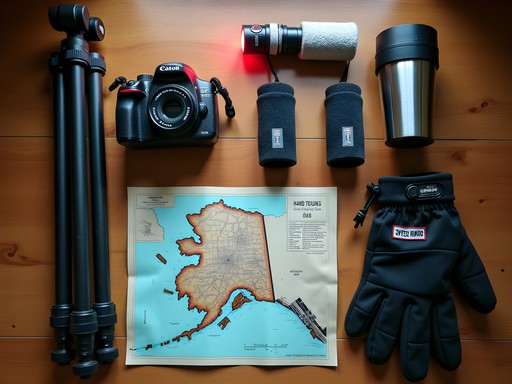


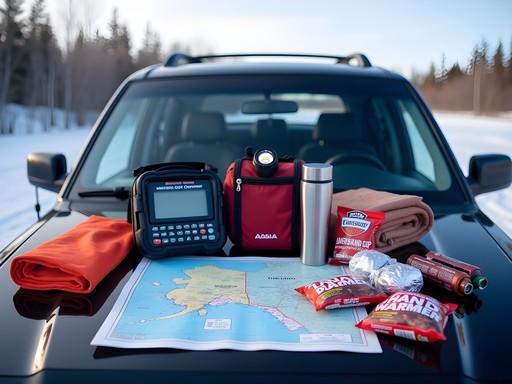











Comments
sunsetseeker
Just got back from Nome after reading your guide! Those survival tips saved me - I seriously underestimated how brutal -20°F feels when you're standing still for hours. Your tip about the layers was spot on. I found that spot you mentioned near Safety Sound and WOW - the lights reflected off the partially frozen water and doubled the show! Only managed decent shots on 2 nights out of 5 due to cloud cover, but totally worth it. For anyone planning a trip, the locals told me November through March is aurora season, but January-February has clearest skies (if you can handle the cold).
lightchaser
Great post! How did you deal with condensation when bringing your camera back indoors? That's always been my biggest struggle in cold environments.
Jason Roberts
Great question! I sealed my gear in airtight bags before going inside, then let it warm up gradually (about 1-2 hours). Prevents that dreaded condensation from forming inside your lens and camera body.
wildseeker226
What camera settings worked best for you? I've got a basic DSLR and kit lens but no idea how to set it up for aurora shots!
luckyking
Not Jason but I use f/2.8 (or widest your lens goes), ISO 1600-3200, and 15-20 sec exposure as starting point. Adjust from there based on how bright the aurora is.
wildseeker226
Thanks! Going to practice these settings before my trip. So excited!
Sophia Gomez
Jason, this guide is exactly what I needed! I'm heading to Nome in two weeks for an assignment and your technical tips about shooting in extreme cold are invaluable. I learned the battery lesson the hard way in Iceland last year - had my spares in an outer pocket and they died within minutes. Now I use my hand warmers to keep them alive. Your point about Anvil Mountain being less crowded than the coastal spots is great intel. Did you find the locals receptive to photographers setting up tripods on their properties? Some places I've been can be quite protective.
sunsetseeker
I'm curious about this too! Planning my first aurora photography trip and worried about trespassing accidentally.
Jason Roberts
Thanks Sophia! The locals in Nome were incredibly welcoming - just be respectful and ask when in doubt. There's plenty of public land around town with great vantage points. The folks at the visitor center can point you to perfect spots that won't ruffle any feathers.
luckyking
Been to Nome twice for the lights. That -20°F is no joke! Your shot of the green swirls above Anvil Mountain is incredible.
wildseeker226
How long did you have to wait for a good show? Planning my first trip there this winter!
luckyking
We got lucky both times - clear skies for 3 of 5 nights. Just check the aurora forecast before you go. The locals say February-March is most reliable.
arcticexplorer42
Just booked my trip after reading this! So excited!
sunnyadventurer
Those aurora photos are incredible! The colors are so vivid. Did you enhance them much in post-processing or is that how they really look? I've never seen the northern lights in person.
Jason Roberts
Thanks! I actually did minimal processing on these. The camera captures more color than the human eye sometimes, but when conditions are right (like they were in Nome), the naked-eye view is pretty spectacular too. Hope you get to experience it someday!
sunnyadventurer
Wow, that makes me want to go even more! Adding Nome to my bucket list for sure.
Taylor Moreau
Excellent write-up on Nome! I visited last December on assignment and can confirm your location recommendations are spot-on. The Safety Roadhouse area provided some of my best shots. One tip I'd add for fellow photographers: I found my camera gloves absolutely essential for operating camera controls in those temperatures. The local guides also showed me a few spots just east of town that weren't on my radar - worth asking about when you arrive. Did you have any luck with time-lapse sequences? Mine kept getting interrupted by the extreme cold shutting down my secondary camera.
mountainphotographer
Taylor, those gloves look perfect! Did you find any particular time of night best for shooting? Planning my schedule now.
Taylor Moreau
In my experience, 10pm-2am offered the best displays, but it really varies. The locals told me activity tends to pick up after midnight, but I got my best shot around 11:30pm. Best to plan for full nights and rest during the day!
mountainphotographer
Jason, this guide is exactly what I needed! I'm heading to Nome in January and was worried about my gear in those temps. Did you have any issues with battery life? I'm planning to bring extras but wondering if there's a specific storage technique you used to keep them from dying in the cold.
Jason Roberts
Batteries are definitely the biggest challenge! I kept spares in an inside pocket close to my body and rotated them. Even with that, I got about half the normal shooting time. Also, bring hand warmers - they're lifesavers for both you and your gear!
mountainphotographer
Thanks for the quick response! Definitely stocking up on hand warmers then. Can't wait to try those locations you mentioned near Anvil Mountain.
Sophia Gomez
Jason, your guide inspired me to finally book my Nome trip after years of hesitation! For anyone nervous about the extreme conditions, I'd add that layering is absolutely critical. I learned this while shooting the northern lights in Svalbard - start with merino wool base layers, add a good mid-layer, and top with windproof/waterproof outer layers. Your section on finding compositions in complete darkness was particularly helpful. I've found that scouting locations during daylight hours and marking GPS coordinates makes nighttime shooting much less stressful.
citymate
The GPS tip is brilliant! Never thought of that.
Venture X
Premium card with 2X miles, $300 travel credit, Priority Pass